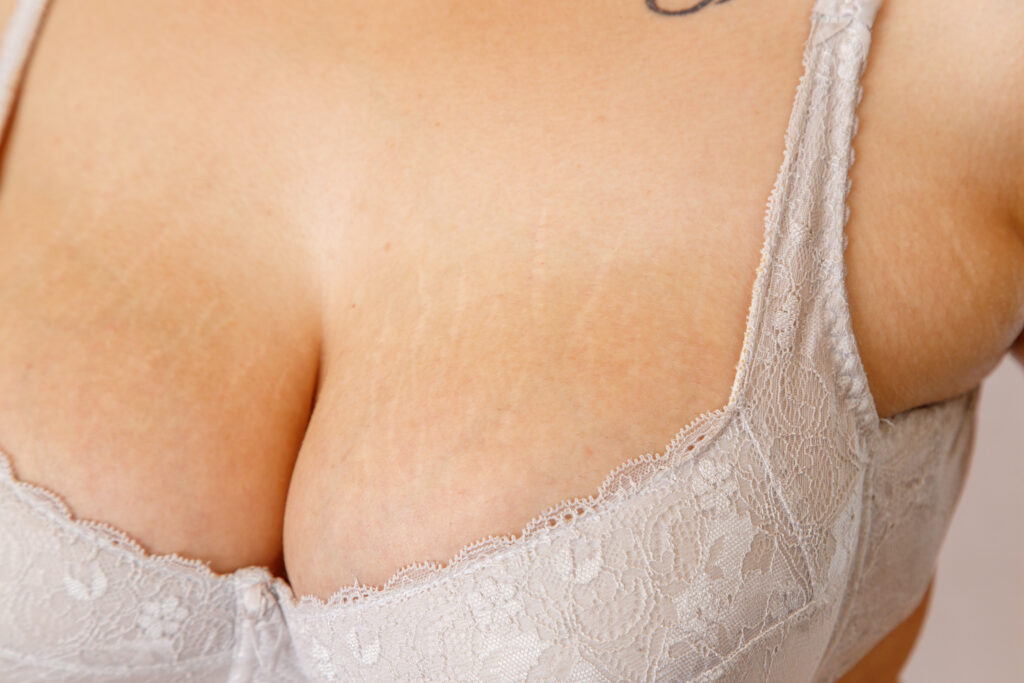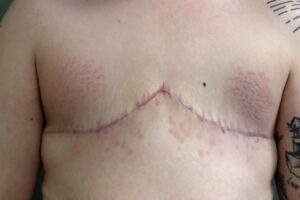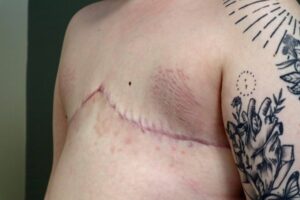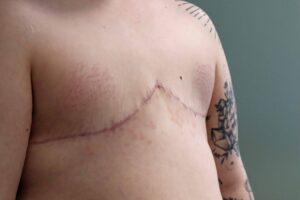
Female-to-male (FTM) and female-to-nonbinary (FTN) gender affirming top surgery can be a remarkably positive, life changing procedure particularly for those individuals experiencing gender dysphoria. In fact, many of my patients have shared with me the tremendous satisfaction and happiness that they have experienced from the desired transformational effects of their surgery. This is also quite clear in observing their behavior, demeanor and positive energy.
Of course, you can also read about this online or by talking with others who have had the procedure.
It is also important to realize that like any surgical procedure or even like most things in life, there are positives and negatives. The downsides includes risks, complications and undesirable occurrences.
That is reality.
Life.
One issue that can occur, though relatively rarely, following FTM or FTN top surgery is the development of stretch marks. At present, these is little mention of this in relationship to top surgery. Below, we will explore this subject and present a patient who did develop these a few months after their procedure.
What are Stretch Marks?
Stretch marks, also known as striae, are a type of scar that appears on the skin when it is stretched rapidly due to various reasons. They typically appear as lines or streaks on the skin’s surface, often with a different color or texture compared to the surrounding skin. Initially, they may appear red, purple or dark brown, but over time, they usually fade to a paler or silvery-white color.
The anatomical basis for this are structural changes and disruptions in the dermis – the middle layer of the skin. Collagen and elastic fibers, important structural elements of the skin, break or tear due to excessive and rapid stretching of the tissues. Collagen is a protein that gives skin its strength and structure. Elastin is a protein that allows the skin to stretch and return to its normal shape. The consequences of this disruption are scars that appear as streaks – that are called stretch marks.
Causes of Stretch Marks
- Stretch marks are most common during periods of rapid growth or stretching of the skin. The most common causes leading to the development of stretch marks include:
- Rapid Weight Gain: A fairly rapid increase of weight can cause the skin to stretch beyond its “capacity”, leading to the formation of stretch marks.
- Pregnancy: During pregnancy, the skin around the abdomen, breasts, and thighs stretches to accommodate the growing baby, which often leads to stretch marks.
- Puberty: There is often rapid growth during puberty which can lead to stretch marks in some people such as on the breasts and thighs.
- Hormonal Changes: Hormonal fluctuations, particularly during pregnancy, puberty, or with the use of certain medications like corticosteroids, can increase the likelihood of stretch marks.
- Genetics: Some people are genetically predisposed to develop stretch marks. Women are also at a higher risk than men.
- Medical Conditions: Certain conditions, such as Cushing’s syndrome, Marfan’s syndrome or Ehlers-Danlos syndrome, can make the skin more prone to developing stretch marks.
- Steroid Use: Topical or oral corticosteroids can weaken the skin’s collagen, making it more vulnerable to stretch marks when the skin is stretched.
- Bodybuilding: Rapid muscle growth through intense workouts can also stretch the skin, leading to stretch marks.
Stretch marks are totally harmless and will fade, to some extent, over time. Typically, they do not completely disappear.
They can be bothersome, however, for cosmetic reasons.
Where are Stretch Marks Seen?
The most common areas for stretch marks to develop include the:
- Abdomen
- Thighs
- Hips
- Buttocks
- Breasts
- Upper arms
What is the Incidence of Stretch Marks Developing after a Plastic Surgery Procedure like a Breast Augmentation?
To provide some perspective of general risks for the development of stretch marks from gender affirming top surgery, let’s first look at the risk for its development in the same anatomical area resulting from a very popular plastic surgery procedure: a breast augmentation.
One retrospective study published in the Aesthetic Surgery Journal in 2024, involving 549 patients, determined this incidence to be 3.1%. Those more likely to develop these were younger in age and had a previous history of developing stretch marks .
What is the Incidence of Stretch Marks Developing after FTM and FTN Gender Affirming Top Surgery?
There is effectively no information presently available – online or through clinical studies – detailing the incidence of stretch marks developing following FTM (female-to-male) and FTN (female-to-nonbinary) gender-affirming top surgery. However, there definitely are questions posted online in forums regarding this issue but I have not seen any scientifically based answers. I do not recall any previous patient of mine inquiring about this prior to their surgery although it is listed in my top surgery consent forms that are reviewed with them and signed.
How commonly do I see stretch marks occurring in my FTM and FTN top surgery patients postoperatively?
Extremely rarely – as far as I can discern.
Most of my top surgery patients are followed for at least 6 months to a year – the time during which such stretch marks would develop. Though I can’t cite specific numbers as this has been such a non-issue, it is my impression that the incidence is under 1% – possibly even under 0.5%.
However, there is a caveat to this.
A significant percentage of these patients already have stretch marks before undergoing surgery. Consequently, the presence of them postoperatively is generally not an issue so if new ones develop, they may not even be noticed or shared with me. This can lead to an under-counting of the incidence of stretch marks following surgery.
Stretch marks are more likely to be seen in FTM and FTN top surgery patients preoperatively:
- with a high BMI (body mass index)
- following massive weight loss
- as a result of chronic binding or taping
- with congenital issues such as Ehlers-Danlos syndrome
Does the Top Surgery Technique Affect Your Risks for Developing Stretch Marks?
The specific technique used for gender affirming top surgery may influence the development of stretch marks postoperatively. However, there is no published scientific data to substantiate this – just anecdotes and critical thinking.
Techniques associated with greater tension on the tissues from skin removal should be associated with a higher risk of developing stretch marks. Consequently, the double incision with/without free nipple graft and the periareolar (concentric circle) techniques should have a higher risk as skin is removed, generally leading to greater tension on the repair. In contrast, the keyhole approach does not remove skin and along with breast tissue removal, the tension on the repair should even be less than before surgery.
Personally, I have only observed the development of stretch marks following the double incision free nipple graft mastectomy. Regardless, this is still a very rare occurrence and this factor alone should not influence one’s selection of the top surgery procedure.
Patient Example
This is a 22 year old patient who had gender dysphoria for many years. They realized 8 years previously that they were gender nonbinary and had been living this way ever since. Binders had been used regularly during this period of time. It is their desire to have gender affirming FTN top surgery without nipples. They already have stretch marks on their chest – prior to surgery. (photos A, C and E)

A). Before FTN top surgery

B). 4 mo. post-op with stretch marks

C). Before FTN top surgery

D.) 4 mo. after FTN top surgery

E.) Before FTN top surgery

F) 4 mo. after FTN top surgery
They underwent top surgery without any untoward issues in the immediate postoperative period. Around two and a half months following their procedure they noticed the onset and development of new stretch marks. Seen at 4 months postoperatively, these stretch marks are symmetrical and noticeable. (photos B, D and F)
Your Consultation
If you have any questions about stretch marks or gender affirming top surgery or want to schedule a consultation with me, Dr. Steven Turkeltaub, you can contact the Arizona Center for Aesthetic Plastic Surgery either by calling (480) 451-3000 or by email.
Steven H. Turkeltaub, M.D. P.C.
Scottsdale and Phoenix, Arizona






